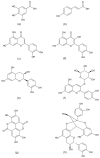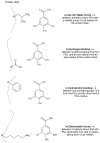Polyphenolic Compounds and Digestive Enzymes: In Vitro Non-Covalent Interactions
- PMID: 28441731
- PMCID: PMC6154557
- DOI: 10.3390/molecules22040669
Polyphenolic Compounds and Digestive Enzymes: In Vitro Non-Covalent Interactions
Abstract
The digestive enzymes-polyphenolic compounds (PCs) interactions behind the inhibition of these enzymes have not been completely studied. The existing studies have mainly analyzed polyphenolic extracts and reported inhibition percentages of catalytic activities determined by UV-Vis spectroscopy techniques. Recently, pure PCs and new methods such as isothermal titration calorimetry and circular dichroism have been applied to describe these interactions. The present review focuses on PCs structural characteristics behind the inhibition of digestive enzymes, and progress of the used methods. Some characteristics such as molecular weight, number and position of substitution, and glycosylation of flavonoids seem to be related to the inhibitory effect of PCs; also, this effect seems to be different for carbohydrate-hydrolyzing enzymes and proteases. The digestive enzyme-PCs molecular interactions have shown that non-covalent binding, mostly by van der Waals forces, hydrogen binding, hydrophobic binding, and other electrostatic forces regulate them. These interactions were mainly associated to non-competitive type inhibitions of the enzymatic activities. The present review emphasizes on the digestive enzymes such as α-glycosidase (AG), α-amylase (PA), lipase (PL), pepsin (PE), trypsin (TP), and chymotrypsin (CT). Existing studies conducted in vitro allow one to elucidate the characteristics of the structure-function relationships, where differences between the structures of PCs might be the reason for different in vivo effects.
Keywords: digestive enzymes; enzymatic inhibition; hydrogen binding; hydrophobic binding; polyphenolic compounds; structure; van der Waals forces.
Conflict of interest statement
The authors declare that no conflicts of interest.
Figures




Similar articles
-
Study of an inhibitory effect of plant polyphenolic compounds against digestive enzymes using bench-working experimental evidence predicted by molecular docking and dynamics.Int J Biol Macromol. 2024 Feb;259(Pt 1):129222. doi: 10.1016/j.ijbiomac.2024.129222. Epub 2024 Jan 6. Int J Biol Macromol. 2024. PMID: 38185307
-
Investigation on the Interaction Behavior Between Oenothein B and Pepsin by Isothermal Titration Calorimetry and Spectral Studies.J Food Sci. 2019 Sep;84(9):2412-2420. doi: 10.1111/1750-3841.14678. Epub 2019 Aug 20. J Food Sci. 2019. PMID: 31429484
-
Mutual influence of piceatannol and bisphenol F on their interaction with pepsin: Insights from spectroscopic, isothermal titration calorimetry and molecular modeling studies.Spectrochim Acta A Mol Biomol Spectrosc. 2019 Jan 5;206:384-395. doi: 10.1016/j.saa.2018.08.028. Epub 2018 Aug 18. Spectrochim Acta A Mol Biomol Spectrosc. 2019. PMID: 30170174
-
Water, treated as the continuous liquid in and around cells.Cell Mol Biol (Noisy-le-grand). 2001 Jul;47(5):721-33. Cell Mol Biol (Noisy-le-grand). 2001. PMID: 11728088 Review.
-
Long-range and short-range mechanisms of hydrophobic attraction and hydrophilic repulsion in specific and aspecific interactions.J Mol Recognit. 2003 Jul-Aug;16(4):177-90. doi: 10.1002/jmr.618. J Mol Recognit. 2003. PMID: 12898668 Review.
Cited by
-
Therapeutic Values of Earthworm Species Extract from Azad Kashmir as Anticoagulant, Antibacterial, and Antioxidant Agents.Can J Infect Dis Med Microbiol. 2022 Feb 7;2022:6949117. doi: 10.1155/2022/6949117. eCollection 2022. Can J Infect Dis Med Microbiol. 2022. PMID: 35228854 Free PMC article.
-
Binding Characteristics and Superimposed Antioxidant Properties of Caffeine Combined with Superoxide Dismutase.ACS Omega. 2019 Oct 7;4(17):17417-17424. doi: 10.1021/acsomega.9b02205. eCollection 2019 Oct 22. ACS Omega. 2019. PMID: 31656914 Free PMC article.
-
Isolation and identification of an antioxidant collagen peptide from skipjack tuna (Katsuwonus pelamis) bone.RSC Adv. 2019 Aug 28;9(46):27032-27041. doi: 10.1039/c9ra04665h. eCollection 2019 Aug 23. RSC Adv. 2019. PMID: 35528566 Free PMC article.
-
Characterization and Influence of Static In Vitro Digestion on Bioaccessibility of Bioactive Polyphenols from an Olive Leaf Extract.Foods. 2022 Mar 3;11(5):743. doi: 10.3390/foods11050743. Foods. 2022. PMID: 35267376 Free PMC article.
-
In vitro Inhibition of Pancreatic Lipase by Polyphenols: A Kinetic, Fluorescence Spectroscopy and Molecular Docking Study.Food Technol Biotechnol. 2017 Dec;55(4):519-530. doi: 10.17113/ftb.55.04.17.5138. Food Technol Biotechnol. 2017. PMID: 29540986 Free PMC article.
References
Publication types
MeSH terms
Substances
LinkOut - more resources
Full Text Sources
Other Literature Sources

